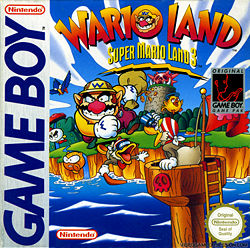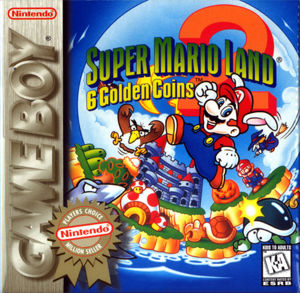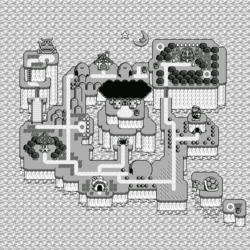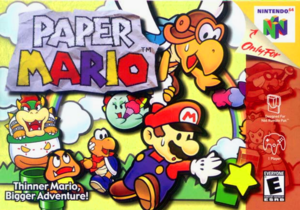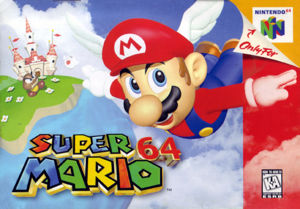Wario Land: Super Mario Land 3
Posted by maparodr | Filed under Juegos de Nintendo de Mario Bros
Wario Land: Super Mario Land 3, known in Japan as Super Mario Land 3: Wario Land (スーパーマリオランド3 ワリオランド), is a game released for the Game Boy in 1994, and is a sequel to Super Mario Land 2: Six Golden Coins. However, "Super Mario Land 3" is a somewhat misleading title, as the game is not really about Mario at all, but rather about Wario. Mario does, however, make a cameo at the end of the game, stealing the statue Wario worked so hard to collect. However, Wario does get his own house or castle (and at the highest amount, a whole planet) as a reward for saving Kitchen Island.
Tags: wario land: mario land 3
Mario Land 2
Posted by maparodr | Filed under Juegos de Nintendo de Mario Bros
Super Mario Land 2: 6 Golden Coins is a popular Player's Choice Game Boy video game. It is the sequel to its more popular predecessor, Super Mario Land,[1] and also marks the debut of Wario, a character who would quickly become one of the main characters of the Mario series. Like its predecessor, Shigeru Miyamoto was not involved in the making of this game. Rather, the game was produced by the late Gunpei Yokoi.
Tags: mario land 2
Mario Land
Posted by maparodr | Filed under Juegos de Nintendo de Mario Bros
Mario Land is where the events of Super Mario Land 2: Six Golden Coins took place. It was the location of Mario's Castle, which Wario stole. The castle hasn't been seen in other games, and has likely been replaced with Mario's House.
Mario Land was also featured in Mario Party 2. The land was split up into different game boards: Horror Land, Western Land, Mini-game Land, Pirate Land, Space Land, and Mystery Land. Additionally, later in the game Bowser and a Baby Bowser kidnapped Toad and took over part of Mario Land, calling it Bowser Land.
The name came about when Mario and his friends were fighting over what the land should be called. Toad convinced them to name the land after whoever defeated Bowser. Depending on who became the superstar, the land could also be called Luigi Land, Wario Land, Peach Land, Yoshi Land, or Donkey Kong Land. However, regardless of the character the land will always end up being called Mario Land in the end.
Tags: mario land
Paper Mario 64
Posted by maparodr | Filed under Juegos de Nintendo de Mario Bros
Paper Mario, known as Mario Story (マリオストーリー Mario Sutōrī) in Japan, is a video game for the Nintendo 64 released in 2000. It was also originally in development for the Nintendo 64DD[2]. Also, the game was the first in its series, and is succeeded in 2004 by Paper Mario: The Thousand-Year Door, which is then succeeded again in 2007 by Super Paper Mario. In July 2007, the game, requiring 270 blocks of memory, was released for the Virtual Console in all regions.
In this game, King Bowser steals the Star Rod from Star Haven and imprisons the seven Star Spirits. He plans to use it to get all his selfish wishes, while everyone else's wishes go ungranted, and after using the Star Rod to destroy Mario and kidnap Princess Peach, he uses his Castle to uproot Peach's Castle into the stratosphere. Now, Peach's Castle is teetering on top of Bowser's. It may look as if the Mushroom Kingdom is doomed with Peach in Bowser's sinister clutches, so Mario and his party members must embark on a mission to set free the Star Spirits, defeat King Bowser, rescue Princess Peach, and take back the Star Rod.
Tags: paper mario
Super Mario 64
Posted by maparodr | Filed under Juegos de Nintendo de Mario Bros
Super Mario 64 is a 3-D platformer game for the Nintendo 64. It was first released in Japan on June 23, 1996; in the U.S. on September 29, 1996; in Europe on March 1, 1997; and in Australia on March 1, 1997. This game was one of two launch titles for the Nintendo 64, along with Pilotwings 64, which helped drive initial sales of the console. To date, it has sold over 11 million copies, and is the second most popular game on the Virtual Console. It is the first game in the Super Mario 3D series.
Super Mario 64 was originally in development for the Super Famicom, or SNES outside of Japan, but was moved to the Nintendo 64 after limitations proved very hassling[1]. Though it was not the first 3-D platforming game, it revolutionized the genre, with many games soon following its formula using it as a sort of benchmark[2]. It is widely acclaimed as one of the greatest games of all time[3][4][5].
A version of the game was released in Japan on July 18, 1997, that included Rumble Pak support. This is actually the same as the International release of the game, as it retains all of the glitch fixes as well as graphical and sound changes (except Mario calling Bowser by his name in a voice clip, which was "buh-bye" in all Japanese versions as he tosses him by the tail - this is because he is not known as Bowser in Japan). The only differences other than one voice clip are the language being changed back to Japanese and the Rumble Pak support.
A remake of Super Mario 64 was released for the Nintendo DS entitled Super Mario 64 DS in 2004. The remake had various differences from the original game. There was also a sequel planned called Super Mario 64 2, though it was canceled.
Tags: Mario 64
Super Mario All-Stars
Posted by maparodr | Filed under Juegos de Nintendo de Mario Bros
Super Mario All-Stars es un videojuego creado por Nintendo para su consola Super Nintendo Entertainment System (Super NES) en 1993. En sí mismo no fue un videojuego nuevo, sino una recopilación de la saga de Super Mario lanzada para su consola antecesora, la Nintendo Entertainment System, llamada comúnmente NES.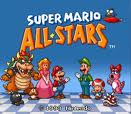
Super Mario All-Stars llevó estos clásicos de la NES al mundo de los 16 bits, brindándoles una muy mejorada gráfica de vivos colores y un sonido estéreo, además de la posibilidad de ir guardando el avance a medida que se pasaban los mundos.
Tags: Mario All Star
Super Mario World
Posted by maparodr | Filed under Juegos de Nintendo de Mario Bros
Super Mario World (originally known in Japan as Super Mario Bros. 4: Super Mario World) was the first Mario launch game for the Super Nintendo Entertainment System, November 21, 1990. The game was produced by Shigeru Miyamoto, the music was composed by Koji Kondo, and the graphics were designed by Shigefumi Hino. This game was playable in the SNES and the Super Famicom. Super Mario World is an unlockable masterpiece in Super Smash Bros. Brawl. To unlock, one must play in the Yoshi's Island stage more than three times.
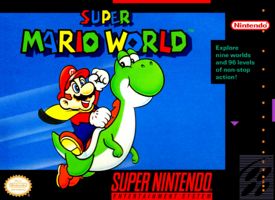
The game has a successor, Super Mario World 2: Yoshi's Island, which is set in the same place and plays similar to its predecessor. However, instead of taking place after Super Mario World, Yoshi's Island took place many years before it.
Tags: Mario World
Super Mario Bros. 3
Posted by maparodr | Filed under Juegos de Nintendo de Mario Bros
Super Mario Bros. 3 (also known by the abbreviation SMB3) is a platform adventure game for the Nintendo Entertainment System. It was released in Japan on October 23, 1988; in North America on February 12, 1990; and in Europe on August 29, 1991. It was later released in the US on the Wii's Virtual Console on November 5, 2007. It is the sequel to Japanese version of Super Mario Bros. 2, although outside of Japan, it is considered the sequel to the Americanized Super Mario Bros. 2.
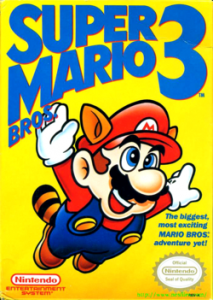
It has been considered as one of the greatest games of all time. Its complexity and challenging levels made it a huge success. In addition to new power ups, it featured new moves, items, and enemies. It also features special non-level parts of each world, including Toad Houses and Spade Panels, as well as some secret parts, such as the White Toad House and the Treasure Ship. Shortly after the release of the game, a cartoon named The Adventures of Super Mario Bros. 3 was made. The cartoon was based on the game, except the plot was changed. In the cartoons, King Koopa and his Koopalings tried to take over the real world as well, and not only the Mushroom Kingdom.
Tags: Mario Bros 3
Super Mario Bros. 2
Posted by maparodr | Filed under Juegos de Nintendo de Mario Bros
Super Mario Bros. 2's genesis came about in 1987, when Nintendo of America got it's first look at the Japanese version of Super Mario Bros. 2. Nintendo of America believed that Super Mario Bros. 2, which was a slightly altered version of the first Super Mario Bros. game with an increased difficulty level, would not be a commercial success in the United States and elsewhere in the world.
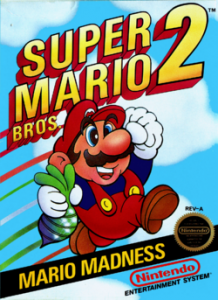
Many characters and abilities from Super Mario Bros. 2 later reappeared in the Super Mario series. Luigi's ability to Jump higher and stay in the air longer than Mario comes from this game, as well as Peach's occasional ability to hover in midair and pull vegetables from the ground (Super Smash Bros. Melee). Shy Guys, Snifits, Bob-ombs, Pokeys, and Birdo were also introduced and would later be incorporated into later Mario Brothers games. Wart, the main villain, never reappeared in a video game, but has made an appearance in the Nintendo Comics System and has been mentioned in later games. He did, however, appear in Legend of Zelda: Link's Awakening under his Japanese name, "Mamu".
Tags: Mario Bros 2
Super Mario Bros.: The Lost Levels
Posted by maparodr | Filed under Juegos de Nintendo de Mario Bros
Super Mario Bros.: The Lost Levels (named Super Mario Bros.: 2 in Japan, and more recently Super Mario Bros. 2: For Super Players), is a Mario game which closely resembles the original Super Mario Bros. and is not to be confused with the European and American Super Mario Bros. 2.
Super Mario Bros. 2 was released in 1986 for the Famicom Disk System to Japan only. It uses a slightly altered Super Mario Bros.'s engine, with different levels and new features including altered graphics and new enemy behavior. Nintendo of America originally deemed this game too challenging and too much like the original to sell well in western countries, so it adapted an unpopular Japanese game called Doki Doki Panic and released it in those parts as Super Mario Bros. 2. 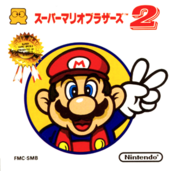
The first time this game was released in Europe and America was its remake in Super Mario All-Stars. Here it was named Super Mario Bros.: The Lost Levels. with text under the box title reading For Super Players.
